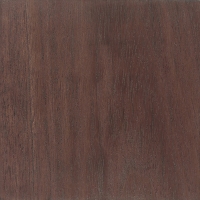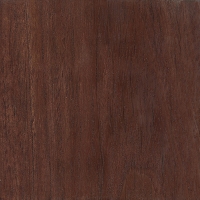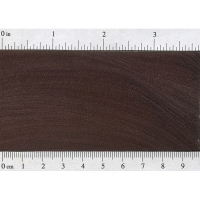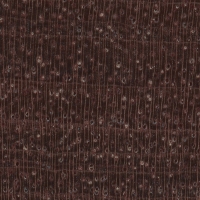 |
Common Name(s): Itin, Caranda Scientific Name: Prosopis kuntzei Distribution: Gran Chaco region of South America Tree Size: 20-35 ft (6-11 m) tall, 1-2 ft (.3-.6 m) trunk diameter Average Dried Weight: 80 lbs/ft3 (1,275 kg/m3) Specific Gravity (Basic, 12% MC): .98, 1.28 Janka Hardness: 3,200 lbf (14,220 N) Modulus of Rupture: 22,300 lbf/in2 (153.8 MPa) Elastic Modulus: 2,520,000 lbf/in2 (17.38 GPa) Crushing Strength: 12,700 lbf/in2 (87.6 MPa) Shrinkage: Radial: 5.5%, Tangential: 6.8%, Volumetric: 14.0%, T/R Ratio: 1.2 |
Color/Appearance: Heartwood tends to be a dark brown, sometimes with purplish patches, sometimes nearly black. Color tends to darken with age. Sapwood is a light yellow color.
Grain/Texture: Itin has a fine to medium texture and open pores, with a slight natural luster. Grain can be straight, wavy, or interlocked.
Endgrain: No data available. Most likely similar to Black Mesquite.
Rot Resistance: Itin is considered durable to very durable regarding decay resistance.
Workability: Itin can be more difficult to work than other species of mesquite in the Prosopis genus on account of its high density, but overall, it is manageable. Glues, turns, and finishes well.
Odor: Itin is said to have a fragrant odor while being worked.
Allergies/Toxicity: Woods in the Prosopis genus have been reported to cause skin irritation. See the articles Wood Allergies and Toxicity and Wood Dust Safety for more information.
Pricing/Availability: Itin only tends to be occasionally available: in small sizes, or as large irregular slabs; it may be sold under the generic term “mesquite.” Larger boards free from defects are uncommon. Prices for Itin are likely to be in the mid range for an imported tropical hardwood.
Sustainability: This wood species is not listed in the CITES Appendices, and is reported by the IUCN as being a species of least concern.
Common Uses: Flooring, firewood, turned objects, cabinetry, furniture, carvings, and other small specialty wood items.
Comments: Itin stands as the densest, hardest, and strongest of the mesquite species found in the Prosopis genus. Some pieces can be quite darkly colored and dense, and Itin has been suggested as an ebony substitute.
 |
 |
 |
 |





Itin (formerly Prosopis kuntzei) has been reclasified by taxonomists as Neltuma kuntzei, but this new name is not popular yet. Other South American Prosopis have also changed. 1. P. alba, (algarrobo blanco) now Vachellia macracantha 2. P. chilensis (algarrobo chileno), now “Vachellia caven” 3. P. flexuosa (alpataco) now Vachellia praecox 4. P. kuntzei (itín, carandá o palo mataco) now Neltuma kuntzei * 5. P. nigra (algarrobo negro) now Vachellia farnesiana 6. P. ruscifolia (vinal) now Mimosa ruscifolia (?) 7 P. rojasiana now Neltuma rojasiana this list is not exhaustive. Following Instituto Darwinion, Prosopis caldenia (calden), and P. torquata (tintitaco) are still… Read more »
Hello, According to INTI, Prosoipis kuntzei weights 1160 Kg/m3, so it may not be the heaviest of the Prosopis genus, being Prosopis torquata at 1180 Kg/m3.
You are probably right. Where did you find the density for P. torquata at 1180 kg/m3?
You can download a pdf in the “INTI” website ( belongs to the argentinian government)
Prosopis torquata(now all prosopis are Neltuma) never reaches big diameters.
I’m an Argentine flutemaker. I had both worked with P kuntzei and P torquata. Although I have no measurements, found that Itin (kuntzei) seems harder and heavier than tintitaco (torquata). But also, it varies from piece to piece. Is very hard to find tintitaco big enough pieces to make a flute. In fact…I have one reserved…maybe for me.
Hello! Here you can see an example of a hand threaded Itin box with an Itin burl inlay (extremely hand to find).
Bellisimo trabajo Mauricio!
I’m trying to identify a Cuban wood commonly referred to as ‘Aroma’ because it has distinctive, pleasant smell when worked or when the bark is removed. I have only seen it in smallish branches, when it is yellow in colour. It is very hard. Itin would seem a likely candidate. Does it grow in Cuba?
in the first photo you can see traces of purple, blue and even green, as product of oxydization. It could end brownish or grayish-black
As you pointed, it could be black, although I tend to say its smokey blueish. I use it as blanks for knife handles, and its great, in spite it lacks of the grandeur of gabon ebony.
Thanks for the website, its something that I needed all my life, as a wood-lover.